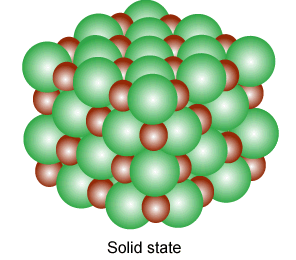Iron oxide $FeO$, crystallises in a cubic lattice with a unit cell edge length of $50 \mathring{A}$ If density of the $FeO$ in the crystal is $40\, g \,cm ^{-3}$, then the number of $FeO$ units present per unit cell is ______ (Nearest integer) Given: Molar mass of $Fe$ and $O$ is $56$ and $16 \, g \, mol ^{-1}$ respectively $N _{ A }=60 \times 10^{23} mol ^{-1}$
Correct Answer: 4
Solution and Explanation
Top Questions on types of cells
- Draw a schematic diagram of an antibody molecule and label any 4 parts. Mention their chemical nature. Name the cells which produce them.
- CBSE CLASS XII - 2024
- Biology
- types of cells
- Name the transgenic animal having the largest number amongst all the existing transgenic animals.
- CBSE CLASS XII - 2024
- Biology
- types of cells
- State any 3 reasons for which these types of animals are being produced.
- CBSE CLASS XII - 2024
- Biology
- types of cells
- Which one of the following is NOT the function of Leyding cells ?
- CUET (UG) - 2023
- Zoology
- types of cells
- For the cell reaction
\(2Fe^{3+}+2I^{-}_{(aq)}\rightarrow2Fe^{2+}+I_2{(aq)}\)
\(E^{\ominus}_{cell}=0.24\ V \ at \ 298 k.\)The standard Gibbs energy \((\Delta_rG^{\ominus})\) of the cell reaction is:
[Given that Faraday constant \( F=96500 \ C\ mol^{-1}]\)- NEET (UG) - 2019
- Chemistry
- types of cells
Questions Asked in JEE Main exam
- An AC current is represented as: $ i = 5\sqrt{2} + 10 \cos\left(650\pi t + \frac{\pi}{6}\right) \text{ Amp} $ The RMS value of the current is:
- JEE Main - 2025
- AC Circuits
Let $ P_n = \alpha^n + \beta^n $, $ n \in \mathbb{N} $. If $ P_{10} = 123,\ P_9 = 76,\ P_8 = 47 $ and $ P_1 = 1 $, then the quadratic equation having roots $ \alpha $ and $ \frac{1}{\beta} $ is:
- JEE Main - 2025
- Relations and functions
- Let \( \langle a_n \rangle \) be a sequence such that \( a_0 = 0 \), \( a_1 = \frac{1}{2} \), and \( 2a_{n+2} = 5a_{n+1} - 3a_n \).n= 0,1,2,3.... Then \( \sum_{k=1}^{100} a_k \) is equal to:
- JEE Main - 2025
- Sequences and Series
Two blocks of masses \( m \) and \( M \), \( (M > m) \), are placed on a frictionless table as shown in figure. A massless spring with spring constant \( k \) is attached with the lower block. If the system is slightly displaced and released then \( \mu = \) coefficient of friction between the two blocks.

(A) The time period of small oscillation of the two blocks is \( T = 2\pi \sqrt{\dfrac{(m + M)}{k}} \)
(B) The acceleration of the blocks is \( a = \dfrac{kx}{M + m} \)
(\( x = \) displacement of the blocks from the mean position)
(C) The magnitude of the frictional force on the upper block is \( \dfrac{m\mu |x|}{M + m} \)
(D) The maximum amplitude of the upper block, if it does not slip, is \( \dfrac{\mu (M + m) g}{k} \)
(E) Maximum frictional force can be \( \mu (M + m) g \)Choose the correct answer from the options given below:
- JEE Main - 2025
- Newtons Laws of Motion
Let \( f : \mathbb{R} \to \mathbb{R} \) be a twice differentiable function such that \[ (\sin x \cos y)(f(2x + 2y) - f(2x - 2y)) = (\cos x \sin y)(f(2x + 2y) + f(2x - 2y)), \] for all \( x, y \in \mathbb{R}. \)
If \( f'(0) = \frac{1}{2} \), then the value of \( 24f''\left( \frac{5\pi}{3} \right) \) is:
- JEE Main - 2025
- Differential Calculus
Concepts Used:
Solid State
Solids are substances that are featured by a definite shape, volume, and high density. In the solid-state, the composed particles are arranged in several manners. Solid-state, in simple terms, means "no moving parts." Thus solid-state electronic devices are the ones inclusive of solid components that don’t change their position. Solid is a state of matter where the composed particles are arranged close to each other. The composed particles can be either atoms, molecules, or ions.

Types of Solids:
Based on the nature of the order that is present in the arrangement of their constituent particles solids can be divided into two types;
- Amorphous solids behave the same as super cool liquids due to the arrangement of constituent particles in short-range order. They are isotropic and have a broad melting point (range is about greater than 5°C).
- Crystalline solids have a fixed shape and the constituent particles are arranged in a long-range order.